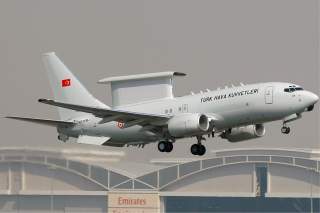Could NATO Turn to the E-7 As Its Newest Plane?
Time to choose.
“There will be things we need to do to the NATO E-3A fleet to keep it flying past 2040.”
Speaking to Reuters, Brig. Gen. Michael Gschossmann, general manager of the NATO AEW&C Programme Management Agency, says the alliance might switch to the Boeing 737 AEW&C platform to replace the aging E-3.
Gschossmann says the 737 has the capacity for new capabilities, such as operating drones for expanded surveillance.
Warning that time is running out to find a replacement for the E-3, Gschossmann suggests that NATO “bet on the proven technology that (it) already have in the E-7.”
According to Gschossmann the E-7 aircraft are large enough to add potential new capabilities, such as operating drones for expanded surveillance, in coming years.
“We have to ensure that we acquire a system that has growth potential, but that also – for financial and time reasons – is based on existing capabilities,” he said.
The AWACS planes are among the few military assets owned and operated by NATO, rather than individual states. They are used to conduct missions such as air policing, support for counter-terrorism operations, evacuations, and crisis response.
NATO is considering the AWACS replacement issue as part of a broader study of surveillance, but the process has dragged out given rapidly changing threats and newly emerging capabilities.
France and the U.S. also operate E-3A aircraft and could potentially buy E-7 planes in coming years, which could lower costs by generating larger order quantities. Britain and Turkey have already purchased the aircraft.
“If you don’t have an idea of what you’re going to do to replace NATO AWACS, then the ‘F’ in Final Lifetime Extension Programme (FLEP) can’t stand for final,” George Riebling, deputy general manager of the agency and a former senior U.S. official said.
“There will be things we need to do to the NATO E-3A fleet to keep it flying past 2040.”
The FLEP program will update the aircraft’s mission system, as well as the processors for its electronic support measures (ESM) antenna. But it does not cover the radar itself, which would have doubled the cost.
Boeing 737 AEW&C is based on a Boeing 737-700, with the addition of an advanced Multi-Role Electronically Scanned Array (MESA) radar, and 10 state-of-the-art mission crew consoles which can track airborne and maritime targets simultaneously.
It is a highly advanced aircraft, providing an airborne early warning and control (AEW&C)platform that can gather information from a wide variety of sources, analyse it, and distribute it to other assets.
The Boeing 737 AEW&C can:
– control the tactical battle space;
– provide direction for assets in the air, at sea and on land;
– support aircraft such as tankers and intelligence platforms.
This article by Dario Leone originally appeared on The Aviation Geek Club in 2019.
Image: Wikimedia

